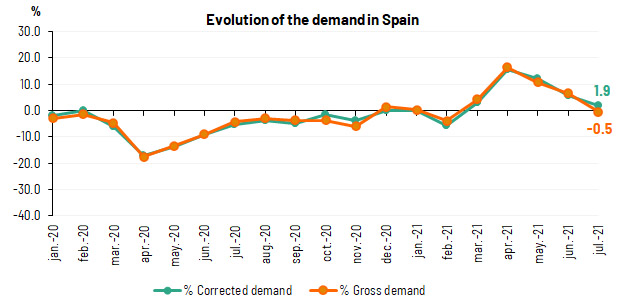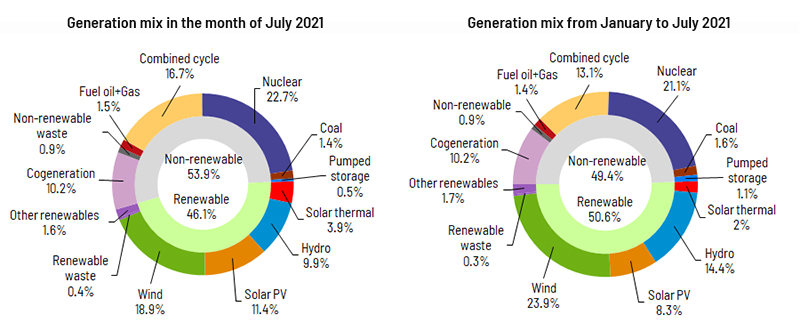For 40 years, we've been driving our country's economic and social progress. Four decades shaping Spain.
Demand for electricity in Spain falls 0.5% in July
- 46.1% of monthly generation came from renewable sources and 69.2% was obtained using technologies which produce zero CO2 equivalent emissions.
- Electricity demand grew by 13.5% in the Balearic Islands and 5.4% in the Canary Islands compared to July 2020.
National electricity demand in July is estimated at 23,086 GWh, a value that is 0.5% lower than the figure registered in the same month last year. However, after having factored in the influence of seasonal and working patterns, the figure is actually 1.9% higher than in July last year.

Compared to a pre-pandemic period (July 2019) and after having factored in the influence of seasonal and working patterns, national electricity demand has fallen 3.4%.
In the first seven months of 2021, demand is estimated at 149,737 GWh, a figure that is 4.2% more than in 2020. Once again, after having factored in the influence of seasonal and working patterns, demand is 4.3% higher than in the same period last year.
During the month of July, and according to data estimated at the time of this press release, generation coming from renewable energy sources represented 46.1% of the generation mix nationwide. During the month, the production of green energy was 13.4% higher than in July 2020.
With the information available at the time of this press release, wind energy generation in July reached 4,279 GWh, a figure that is 0.7% higher than in the same month last year, and accounted for 18.9% of total production nationwide, being the second technology that contributed most to the mix in this month, only surpassed by nuclear (22.7%) and followed by combined cycle, which produced 16.7%.
In addition, 2,576 GWh of solar photovoltaic energy was produced in July, a figure that is 35.4% higher than in the same month last year, and accounted for 11.4% of the total generation mix. As a result of this, July 2021 registered the highest level of monthly solar photovoltaic generation since records began in Red Eléctrica (2007).
69.2% of electricity production in July was obtained using technologies which produce zero CO2 equivalent emissions (GHG).

Demand for electrical energy in the peninsular electricity system falls 1%
Demand for electrical energy in the mainland electricity system in July is estimated at 21,732 GWh, down 1% on July 2020. After having factored in the influence of seasonal and working patterns, the demand for electricity is 1.4% higher than that registered in the same month last year.
Compared to a pre-pandemic period (July 2019) and after having factored in the influence of seasonal and working patterns, electricity demand on the peninsula has fallen 3%.
From January to July 2021, electricity demand on the Spanish mainland is estimated at 141,979 GWh, a value that is 4.4% higher than in 2020. In this case, after having factored in the influence of seasonal and working patterns, adjusted demand is still 4.4% higher than that recorded in the same period last year.
During July, and according to data estimated at the time of this press release, 47.8% of generation on the mainland came from renewable energy sources and 72.4% was obtained using technologies which produce zero CO2 equivalent emissions. For its part, wind energy stood at 4,112 GWh, up 0.3% on July last year, and solar photovoltaic totalled 2,528 GWh, an increase of 35.7% compared to July 2020.
Demand for electricity in July increases 13.5% in the Balearic Islands and 5.4% in the Canary Islands
In the Balearic Islands, the demand for electricity in July is estimated at 600,395 MWh, a value that is 13.5% higher than that recorded in July 2020. After factoring in the influence of seasonal and working patterns, the figure is up 16.5% on that recorded in July 2020.
Compared to a pre-pandemic period (July 2019) and after having factored in the influence of seasonal and working patterns, electricity demand on the Balearic Islands has fallen 12.2%.
In the first seven months of 2021, electricity demand in the Balearic Islands is estimated, in gross terms, at 3,061,434 MWh, a figure that is 9.2% higher than in the same period in 2020.
Combined cycle, with 75.9% of the total production in the Balearic Islands, was the leading source of electricity generation in July in the archipelago, followed by electricity produced with diesel engines (9.5%). This month, renewable energy and those technologies which produce zero CO2 equivalent emissions accounted for 5.6% of the overall generation mix of the Balearic Islands.
Furthermore, during the month, energy transferred via the Spanish Peninsula-Majorca submarine link contributed to covering 7.6% of the electricity demand in the Balearic Islands.
Regarding the Canary Islands, electricity demand is estimated at 715,842 MWh, up 5.4% on that recorded in July 2020. After factoring in the influence of seasonal and working patterns, the figure is 6.4% higher than that registered in the same month last year.
Compared to a pre-pandemic period (July 2019) and after having factored in the influence of seasonal and working patterns, the demand for electricity in the Canary Islands has fallen 6.4%.
From January to July 2021, electricity demand in the Canary Islands is estimated, in gross terms, at 4,464,301 MWh, a figure that is 2% less than in the same period last year.
In the Canary Islands, combined cycle, with a 41.1% share of the total mix, was the leading source of electricity generation in July, while renewables and those technologies which produce zero CO2 emissions accounted for 27.9% of the overall generation mix of the Canary Islands.
Consult our Daily Balance Report for more information on the National, Peninsular, Balearic Islands and Canary Islands electricity systems as at the close of July.












